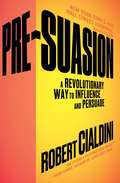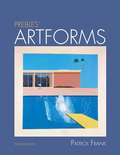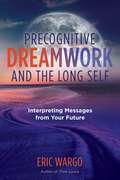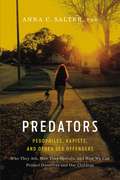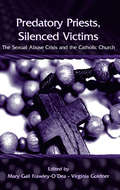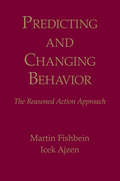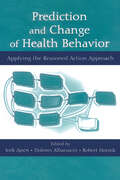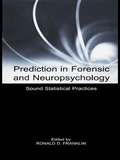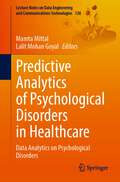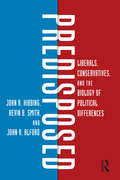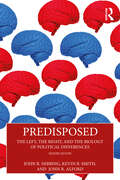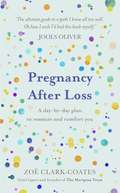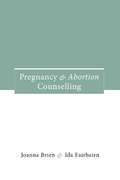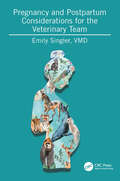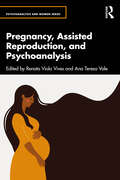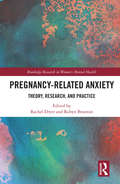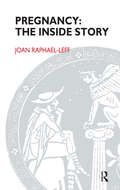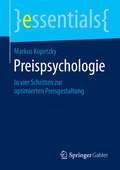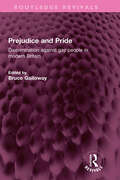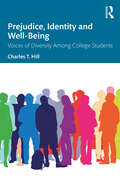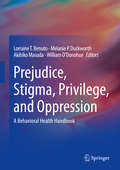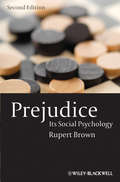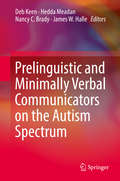- Table View
- List View
Pre-Referral Intervention Manual Fourth Edition
by Samm N. House Kathy Cummins Wunderlich Stephen B. MccarneyGenerally, the pre-referral process begins with a regular educator calling attention to a student with learning and/or behavior problems. A team of educators, typically composed of a special educator(s), a regular educator(s), and/or a counselor(s) from that building, meets with the educator identifying a student for pre-referral intervention. The team, along with input from the teacher calling attention to the student's needs, pinpoints the specific learning and/or behavior concerns for improvement. Goals and objectives for the student in the regular classroom are formally or informally determined, and intervention strategies for the school environment are agreed upon. With consultant assistance from the pre-referral team, the classroom teacher conducts adjusted behavior and teaching approaches for the student for a specific length of time, which may be for several weeks up to a few months. The student's progress is documented and communication continues between the pre-referral team and the classroom teacher. Based on student performance in response to pre-referral intervention strategies, decisions are made as to the student's ability to succeed in the regular classroom with adjustments in instruction, materials, testing, etc. If the student is successful with these adjustments, he/she remains in the regular classroom with continued support. If the student is not successful; formal referral, assessment, and special education services are likely to follow.
Pre-Suasion: A Revolutionary Way to Influence and Persuade
by Robert CialdiniThe author of the legendary bestseller Influence, social psychologist Robert Cialdini shines a light on effective persuasion and reveals that the secret doesn't lie in the message itself, but in the key moment before that message is delivered.What separates effective communicators from truly successful persuaders? Using the same combination of rigorous scientific research and accessibility that made his Influence an iconic bestseller, Robert Cialdini explains how to capitalize on the essential window of time before you deliver an important message. This "privileged moment for change" prepares people to be receptive to a message before they experience it. Optimal persuasion is achieved only through optimal pre-suasion. In other words, to change "minds" a pre-suader must also change "states of mind." His first solo work in over thirty years, Cialdini's Pre-Suasion draws on his extensive experience as the most cited social psychologist of our time and explains the techniques a person should implement to become a master persuader. Altering a listener's attitudes, beliefs, or experiences isn't necessary, says Cialdini--all that's required is for a communicator to redirect the audience's focus of attention before a relevant action. From studies on advertising imagery to treating opiate addiction, from the annual letters of Berkshire Hathaway to the annals of history, Cialdini draws on an array of studies and narratives to outline the specific techniques you can use on online marketing campaigns and even effective wartime propaganda. He illustrates how the artful diversion of attention leads to successful pre-suasion and gets your targeted audience primed and ready to say, "Yes."
Prebles' Artforms
by Duane Preble Sarah Preble Patrick L. FrankPrebles' Artforms continues to lead the field with its steadfast focus on contemporary art, global artists, and cutting edge technology for the art appreciation classroom. We form Art. Art forms us. The title of this book has a dual meaning. Besides the expected discussion of the various forms of art, the title also reflects the fact that art does indeed help to form us as people. As we create forms, we are in turn formed by what we have created. Several years ago, the title was changed to Prebles' Artforms, acknowledging the pioneering contribution of the original authors, Duane and Sarah Preble, to the study of art. Their vision and spirit have touched hundreds of thousands of students who have studied this book. Artforms grew out of a desire to introduce art through an engaging visual experience, and to expose students to a culturally diverse canon of work. It is written and designed to help readers build an informed foundation for individual understanding and enjoyment of art. By introducing art theory, practice, and history in a single volume, this book aims to draw students into a new or expanded awareness of the visual arts. Beyond fostering appreciation of major works of art, this book's primary concern is to open students' eyes and minds to the richness of the visual arts as unique forms of human communication and to convey the idea that the arts enrich life best when we experience, understand, and enjoy them as integral parts of the process of living.
Precognitive Dreamwork and the Long Self: Interpreting Messages from Your Future
by Eric Wargo• Outlines a set of clear principles to help guide dreamworkers, illustrated through real precognitive dream experiences • Shows how to detect precognitive dreams through their characteristic features, explaining how dreams relate to memory and why dreams about future experiences are often symbolic or distorted • Explores the mind-blowing implications of precognition for our lives, including how our present thoughts actually shape--or shaped--our past Once only the stuff of science fiction, evidence has grown that precognition--glimpses of your future in dreams and visions and being influenced subtly in waking life by what is to come--is real. Your future thoughts and feelings shape who you are now. And your present thoughts and feelings shape--or shaped--your past. In this accessible exploration of precognition, precognitive dreamwork, and a radically new biographical sensibility, the Long Self, that precognition awakens us to, Eric Wargo shows how dreamworkers can play the role of citizen scientists, adding to our understanding of this fascinating, almost unexplored dimension of human life. Wargo outlines a set of clear principles to guide dreamworkers, each illustrated through real dreamers&’ experiences. Drawing on psychoanalysis and contemporary sleep science, he explores how precognition relates to memory, explaining why dreams of future experiences are often distorted and what those distortions probably mean. He discusses never-before-described dream features, including &“time gimmicks&” (symbols hinting at time distortion) and &“calendrical resonance&” (the tendency of dreams to foretell experiences exactly a year or years later). He describes why an understanding of precognition augments Jung&’s theory of synchronicity by highlighting our own role in producing meaningful coincidences in our waking lives. He also shows how precognition manifests in other states of consciousness like lucid dreams, out-of-body experiences, trance states, sleep paralysis, meditation, and hypnagogia. We are at a major turning point in science&’s understanding of time, causality, and the self. We are more than who we think we are from moment to moment--we are our past, present, and future simultaneously. When we understand this, a dream journal becomes a personal time machine, with mind-blowing discoveries in store for the traveler.
Predators: Pedophiles, Rapists, And Other Sex Offenders
by Anna SalterWhat motivates sexual abusers? Why are so few caught? Drawing on the stories of abusers, Anna C. Salter shows that sexual predators use sophisticated deception techniques and rely on misconceptions surrounding them to evade discovery. Arguing that even the most knowledgeable among us can be fooled, Salter dispels the myths about sexual predators and gives us the tools to protect our families and ourselves.
Predatory Priests, Silenced Victims: The Sexual Abuse Crisis and the Catholic Church
by Virginia Goldner Mary Gail Frawley-O’DeaThe sexual abuse scandal in the Catholic Church captured headlines and mobilized public outrage in January 2002. But much of the commentary that immediately followed was reductionistic, focusing on single "causes" of clerical abuse such as mandatory celibacy, homosexuality, sexual repressiveness or sexual permissiveness, anti-Catholicism, and a decadent secular culture. Predatory Priests, Silenced Victims: The Sexual Abuse Crisis and the Catholic Church, a collection of groundbreaking articles edited by Mary Gail Frawley-O'Dea and Virginia Goldner, eschews such one-size-fits-all theorizing. In its place, the abuse situation is explored in all its troubling complexity, as contributors take into account the experiences, respectively, of the victim/survivor, the abuser/perpetrator, and the bystander (whether family member, professional/clergy, or the community at large). Setting polemics to the side, Predatory Priests, Silenced Victims provides a sober and sobering analysis of the interlacing historical, doctrinal, and psychological issues that came together in the sexual abuse scandal. It is mandatory reading for all who seek thoughtful, informed commentary on a crisis long in the making and yet to be resolved.
Predicting and Changing Behavior: The Reasoned Action Approach
by Martin Fishbein Icek AjzenThis book describes the reasoned action approach, an integrative framework for the prediction and change of human social behavior. It provides an up-to-date review of relevant research, discusses critical issues related to the reasoned action framework, and provides methodological and conceptual tools for the prediction and explanation of social behavior and for designing behavior change interventions.
Prediction and Change of Health Behavior: Applying the Reasoned Action Approach
by Dolores Albarracín Icek Ajzen Robert HornikPrediction and Change of Health Behavior honors the work of Martin Fishbein by illustrating the breadth and depth of the reasoned action approach. Focused on attitudes and their effects on health-related behavior, the book demonstrates the profound impact of Fishbein and Ajzen’s theories of reasoned action on attitude research and on the solu
Prediction in Forensic and Neuropsychology: Sound Statistical Practices
by Ronald D. FranklinPsychologists are under increasing pressure to demonstrate the ecological validity of their assessment procedures--to show that the recommendations concluding their evaluations are relevant to urgent concerns in the legal and social policy arenas, such as predicting dangerousness, awarding compensation, and choosing a custodial parent. How much damage does a referred patient have? Who or what "caused" the damage? What impact will it have on his or her future life, work, and family? And what can be done to remediate the damage? The purpose of this book is to provide sound objective methods for answering these questions. It integrates the knowledge of experienced practitioners who offer state-of-the-art summaries of the best current approaches to evaluating difficult cases with that of basic theorists who describe emerging methods in both predictive and inferential statistics, such as Bayesian networks, that have proven their value in other scientific fields. Arguably, the enterprise of psychological assessment is so interdependent with that of data analysis that attempts to make inferences without consideration of statistical implications is malpractice. Prediction in Forensic and Neuropsychology: Sound Statistical Practices clarifies the process of hypothesis testing and helps to push the clinical interpretation of psychological data into the 21st century. It constitutes a vital resource for all the stakeholders in the assessment process--practitioners, researchers, attorneys, and policymakers.
Predictive Analytics of Psychological Disorders in Healthcare: Data Analytics on Psychological Disorders (Lecture Notes on Data Engineering and Communications Technologies #128)
by Mamta Mittal Lalit Mohan GoyalThis book discusses an interdisciplinary field which combines two major domains: healthcare and data analytics. It presents research studies by experts helping to fight discontent, distress, anxiety and unrealized potential by using mathematical models, machine learning, artificial intelligence, etc. and take preventive measures beforehand. Psychological disorders and biological abnormalities are significantly related with the applications of cognitive illnesses which has increased significantly in contemporary years and needs rapid investigation. The research content of this book is helpful for psychological undergraduates, health workers and their trainees, therapists, medical psychologists, and nurses.
Predisposed: Liberals, Conservatives, and the Biology of Political Differences
by Kevin B. Smith John R. Alford John R. HibbingBuried in many people and operating largely outside the realm of conscious thought are forces inclining us toward liberal or conservative political convictions. Our biology predisposes us to see and understand the world in different ways, not always reason and the careful consideration of facts. These predispositions are in turn responsible for a significant portion of the political and ideological conflict that marks human history. With verve and wit, renowned social scientists John Hibbing, Kevin Smith, and John Alford—pioneers in the field of biopolitics—present overwhelming evidence that people differ politically not just because they grew up in different cultures or were presented with different information. Despite the oft-heard longing for consensus, unity, and peace, the universal rift between conservatives and liberals endures because people have diverse psychological, physiological, and genetic traits. These biological differences influence much of what makes people who they are, including their orientations to politics. Political disputes typically spring from the assumption that those who do not agree with us are shallow, misguided, uninformed, and ignorant. Predisposed suggests instead that political opponents simply experience, process, and respond to the world differently. It follows, then, that the key to getting along politically is not the ability of one side to persuade the other side to see the error of its ways but rather the ability of each side to see that the other is different, not just politically, but physically. Predisposed will change the way you think about politics and partisan conflict. As a bonus, the book includes a "Left/Right 20 Questions" game to test whether your predispositions lean liberal or conservative.
Predisposed: The Left, The Right, and the Biology of Political Differences
by Kevin B. Smith John R. Alford John R. HibbingThis thoughtfully updated revision of a classic text sheds new light on the potential sociological and biological differences that result in deep, seemingly unbridgeable political divisions.Renowned social scientists and experts in biopolitics, John R. Hibbing, Kevin B. Smith, and John R. Alford present overwhelming evidence that political opinion is shaped not just by cultural background or information bias but is rather the result of diverse psychological, physiological, and genetic traits. This new edition shifts the emphasis from differences between the political left and the right (liberals and conservatives) as they have traditionally been understood and explores specific brands of liberalism and conservatism such as ardent supporters of politicians such as Donald Trump.An essential read for students and scholars of political psychology and party politics, this book invites the reader to reconsider their perspectives on public opinion and partisan conflict.
Pregnancy After Loss: A day-by-day plan to reassure and comfort you
by Zoë Clark-CoatesPregnancy after baby loss can be a scary and isolating experience, a path I know all too well. Zoe has managed to yet again create the ultimate guide and blueprint for anyone navigating this, to not only help them survive the next 9-months, but also to flourish and enjoy this magical time. The pages are packed with crucial advice, tips to overcome anxiety, stories from people who have encountered baby loss and journeyed subsequent pregnancies, wisdom from experts in healthcare, guidance to help process layers of grief, coupled with a day-by-day support journal to walk you through your entire pregnancy. Oh, how I wish I had had 'Pregnancy After Loss' myself. -- Jools OliverPregnancy should be a time of joyous anticipation, but those forty weeks can feel very different if you are one of the many women who has previously lost a baby. In Pregnancy After Loss, Zoe Clark-Coates has created a compassionate and essential guide to lead you, day by day, through your pregnancy. Addressing such issues as facing fear, coping with scans and pregnancy milestones, building relationships with your medical team and processing your ongoing grief whilst pregnant, this is the comforting companion every pregnant woman needs by her side. As someone who has experienced pregnancy following baby loss, Zoe fully understands all of the concerns you may be experiencing - she has been there, and now she's here for you.
Pregnancy and Abortion Counselling
by Joanna Brien Ida FairbairnPregnancy and Abortion Counselling is written for professionals who give information and support to women deciding whether to terminate or continue with their pregnancy. The authors provide a comprehensive review of the social, moral and legal issues surrounding contraception and abortion and offer clear guidelines for establishing good practice. Illustrated throughout with case examples the book includes detailed information on * current legislation * methods of abortion * stages of foetal development * screening for foetal abnormality * client confidentiality and consent * ethical considerations This book is relevant to many health professionals, including doctors, health visitors, midwives and nurses as well as those involved in community work and counselling.
Pregnancy and Postpartum Considerations for the Veterinary Team
by Emily SinglerPrecautions often apply to pregnancy in any workplace, but being a vet in practice presents additional specific risks. There are concerns and uncertainty about potential hazards, from radiation and inhalant anesthesia exposure, to zoonoses, and the additional mental stress in a profession that already carries high suicide risk. This book reviews considerations for professionals in clinical veterinary medicine (large and small animal) while pregnant and after giving birth. Veterinarian and veterinary writer, consultant, and mentor Dr Emily Singler speaks directly to veterinary team members (veterinarians, technicians, CSRs, assistants, students) who are pregnant or plan to become pregnant. She delivers scientific information on the specific risks to the mother and baby that may be encountered during pregnancy while working in veterinary medicine, with some of her own and others’ experiences to add perspective and humor. The book also covers topics related to mental health challenges, announcing a pregnancy and planning for parental leave, navigating the fourth trimester, and returning to work. We hope that having read this book, veterinary professionals – whether pregnant or working with pregnant colleagues – will feel better supported and empowered to make informed decisions.
Pregnancy, Assisted Reproduction, and Psychoanalysis (Psychoanalysis and Women Series)
by Renata Viola Vives Ana Teresa ValePregnancy, Assisted Reproduction, and Psychoanalysis reflects on contemporary views on pregnancy, while offering guidance on how to work with women and couples experiencing infertility as well as the unique issues raised by having a child through assisted reproduction technologies.Comprised of chapters written by eminent analysts working with infertile couples and women, and parents who have a child born from assisted reproduction, this book offers insightful ways to better understand the challenges these patients undertake and the various issues this might bring into the analytic room. The contributors examine the myriad psychic problems subjects are confronted with which could impact their ability to bond with children born through ART: the mourning processes infertility entails, the identification with the fertile parental couple, the unconscious representation of origin, the representation of the primal scene, and the process of symbolic affiliation. They consider the working-through these processes necessitate in order to enable filiation and healthy parenting, and give invaluable tools to the analyst to enable the promotion of psychological growth. Throughout, the chapters address the emotions that infertility summons in which both patient and analyst find a spectrum of unconscious phantasies and anxieties.This book is an essential read for psychoanalysts and other professionals working in the field of ART, as well as those interested in motherhood and its vicissitudes and intersection with psychoanalysis.
Pregnancy-Related Anxiety: Theory, Research, and Practice (Routledge Research in Women's Mental Health)
by Rachel Dryer Robyn BruntonThis book provides a collective examination of the theoretical, empirical, and clinical perspectives of pregnancy-related anxiety. Pregnancy-related anxiety is a distinct form of anxiety that is experienced by pregnant women and is characterized by pregnancy-specific fears and worries. This form of anxiety has been associated with a range of negative obstetric, neonatal, and maternal outcomes. There has been increased research interest in this form of anxiety, particularly over the last 15 years. The content is organized in three sections. The first section provides a thorough understanding of pregnancy-related anxiety, ranging from its historical development, evidence of its distinctiveness to the antecedents and outcomes of this anxiety for the mother and child. The second section examines key clinical issues around diagnosis and treatment specifically, current diagnosis/screening for this anxiety and approaches for intervention and treatment. The final section considers emerging areas of research such as pertinent issues around culture and acculturation which are key issues in an increasingly multicultural world. Moreover, the effects of pregnancy-related anxiety on the woman’s broader psychosocial functioning are considered with specific chapters on body image and sexual abuse, two key areas of concern. A seminal resource, this book provides a broad examination of the topic from multiple frameworks and perspectives which sets this book apart from other books in print. This book intends to inform and stimulate future research studies, as well as increase awareness and understanding of pregnancy-related anxiety. It is a must-read for researchers, educators, clinicians, and higher education students who care about delivering better support and services to pregnant women, particularly those who are vulnerable and distressed.
Pregnancy: The Inside Story (Master Work Ser.)
by Joan Raphael-LeffUtilising her wealth of material and experience, the author explores various aspects of 'the inside story' of pregnancy. She answers such questions as: What meanings does childbearing have in the internal world? How does a pregnant woman live with two people under her skin? What is the expectant partner's experience? Which dreams, fears and fantasies proliferate around pregnancy and birth?
Preispsychologie: In vier Schritten zur optimierten Preisgestaltung (essentials)
by Markus Husemann-KopetzkyMarkus Husemann-Kopetzky zeigt, dass Unternehmen durch eine gezielte Preisdarstellung die Preiswahrnehmung von Kunden und dadurch mittelbar ihr Verhalten beeinflussen können. Dabei stellt er dar, wie die Preispsychologie zur Preisgestaltung systematisch genutzt werden kann, und entwickelt ein Strukturierungsschema – das 4-P-Modell der Preispsychologie – zur Sortierung der einzelnen preispsychologischen Erkenntnisse sowie zur Auswahl einer psychologisch optimierten Preisgestaltung. Der Autor vermittelt dem Leser einen breiten und fundierten Eindruck zur Preispsychologie und zeigt dabei Möglichkeiten zur weiteren Vertiefung auf. Diese zweite überarbeitete Auflage wurde um neue Studien aus dem noch sehr dynamischen Forschungsgebiet der Preispsychologie aktualisiert. Der Autor:Dr. Markus Husemann-Kopetzky ist externer Habilitand bei Prof. Dr. Andreas Eggert am Lehrstuhl für Betriebswirtschaftslehre, insbesondere Marketing, an der Universität Paderborn und als Senior Manager Pricing and Business Analytics bei einem großen Internet-Versandhandel tätig.
Preispsychologie: In vier Schritten zur optimierten Preisgestaltung (essentials)
by Markus KopetzkyMarkus Kopetzky zeigt, dass Unternehmen durch eine gezielte Preisdarstellung die Preiswahrnehmung von Kunden und dadurch mittelbar ihr Verhalten beeinflussen können. Dabei stellt er dar wie die Preispsychologie zur Preisgestaltung systematisch genutzt werden kann und entwickelt ein Strukturierungsschema - das 4-P-Modell der Preispsychologie - zur Sortierung der einzelnen preispsychologischen Erkenntnisse sowie zur Auswahl einer psychologisch optimierten Preisgestaltung. Der Autor vermittelt dem Leser einen breiten und fundierten Eindruck zur Preispsychologie und zeigt dabei Möglichkeiten zur weiteren Vertiefung auf.
Prejudice and Pride: Discrimination against gay people in modern Britain (Routledge Revivals)
by Bruce GallowayFirst published in 1983, Prejudice and Pride chronicles legal and social discrimination against gay people living in Britain in 1980s. The book alerts its readers to the ways in which gay men and women were treated in our society and how discrimination in each area can be tackled. The book speaks to us all, providing a blueprint for action through the 1980s. While things today might be better, the book is a reminder that the struggle for equal rights was and will continue to be long and cumbersome. The book acknowledges the action and support of the Campaign for Homosexual Equality and will be of interest to students of history, sociology, law, gender studies and sexuality studies.
Prejudice, Identity and Well-Being: Voices of Diversity Among College Students
by Charles T. HillThis essential and timely text looks at the ways in which various identities are socially constructed by students, exploring and comparing multiple dimensions of diverse identities, and the various ways students try to fit in when faced with prejudice and discrimination. Based on more than 20 years of data collected from Multiple Identities Questionnaires, plus Self-Identity papers in the author’s Diverse Identities course, this book gives voice to the diverse and intersectional identities experienced by students at a formative time in their lives. Analyzing data from more than three thousand college students, the book gives a uniquely comprehensive overview of identity formation, stigma, prejudice, and discrimination, which are part of conflict around the world. Author Charles T. Hill asks to what extent the students have experienced prejudice or discrimination regarding each of their identities, their own prejudice and discrimination toward others of each identity, and the importance of each type of identity for their self-concept. Split into three sections: the first part of the book gives an overview of terminologies and theoretical concepts, the second part explores the multiple dimensions of each identity using data from the MIQ interspersed with quotes from Self-Identity papers, and the third part compares and combines the different types of identities. Introduced with a foreword by Professor Emeritus of Africana Studies James M. Jones, the book opens a space to help students and others explore their identities, realize that they are not alone in their struggles with prejudice, and accept themselves with pride in their identities. Featuring highlighted key concepts and self-reflection sections, as well as further reading, measures, and statistical results, this book is essential not only for undergraduate and graduate students in social psychology, health psychology, sociology, ethnic studies, and social work, but also for therapists, parents, teachers and practitioners running Diversity Training Programs for non-students.
Prejudice, Stigma, Privilege, and Oppression: A Behavioral Health Handbook
by Lorraine T. Benuto Akihiko Masuda Melanie P. Duckworth William O’DonohueThis book addresses the ways in which clinical psychologists ought to conceptualize and respond to the prejudice and oppression that their clients experience. Thus, the link between prejudice and oppression to psychopathology is explored. Basic scientific information about prejudice is reviewed, and the current status of the major minority groups is explored. Chapters examine the role of prejudice and oppression in institutional structures such as the Diagnostic and Statistical Manual of Mental Disorders and professional organizations. The discussion addresses ways to assess these phenomena in individual cases and how to intervene in psychotherapy. The book ventures to evaluate the status of the profession of psychology with respect to prejudice, stigmatization, and oppression by critically examining evidence that the profession has responded adequately to these social problems. These issues are hard to talk about and are not well talked about in the field. This book is a push in the right direction.
Prejudice: Its Social Psychology
by Rupert BrownThis new edition of Prejudice provides a comprehensive treatment of the subject, introducing the major theoretical ideas as well as providing a critical analysis of recent developments. Takes a social psychological perspective, analysing individual behavior as part of a pattern of intergroup processes Covers the major research, including classical personality accounts, developmental approaches, socio-cognitive research focussing on categorization and stereotyping, prejudice as an intergroup phenomenon, and ways to combat prejudice Illustrates concepts with examples of different kinds of prejudice drawn from everyday life Includes a new chapter on prejudice from the victim's perspective Fully updated throughout, with expansion of the notions of explicit and implicit manifestations of prejudice
Prelinguistic and Minimally Verbal Communicators on the Autism Spectrum
by Deb Keen Hedda Meadan Nancy C. Brady James W. HalleThis book draws on contemporary theory and recent findings to provide researchers, professionals, undergraduate and graduate students with essential resources, allowing them to better understand and support children, youth and adults with autism and significant communication impairments. The book consists of 11 chapters organized into 3 sections detailing typical and atypical prelinguistic development for individuals on the autism spectrum, together with a range of assessment and intervention approaches that clinicians and educators can draw on in practice. The book adopts a lifespan perspective, recognizing that there is an important and particularly challenging sub-group of children on the spectrum who remain minimally verbal beyond the age of 8 years. Each chapter summarizes current research on a selected topic, identifies key challenges faced by researchers, educators and clinicians, and considers the implications for research and practice. The concluding chapter considers issues of research translation and how educators and clinicians can encourage the use of evidence-based practices for prelinguistic and minimally verbal individuals.

